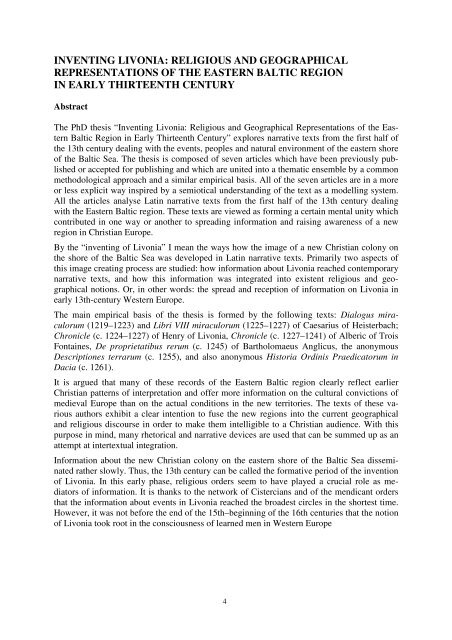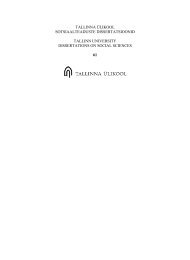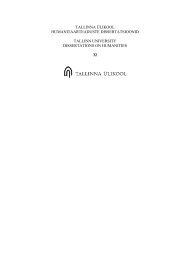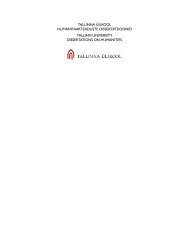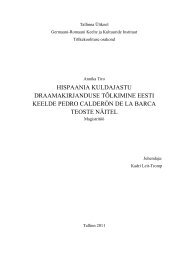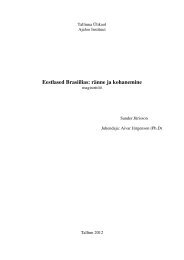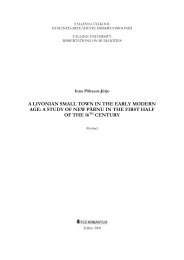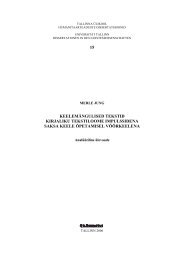You also want an ePaper? Increase the reach of your titles
YUMPU automatically turns print PDFs into web optimized ePapers that Google loves.
INVENTING LIVONIA: RELIGIOUS AND GEOGRAPHICAL<br />
REPRESENTATIONS OF THE EASTERN BALTIC REGION<br />
IN EARLY THIRTEENTH CENTURY<br />
Abstract<br />
The PhD thesis “Inventing Livonia: Religious and Geographical Representations of the Eastern<br />
Baltic Region in Early Thirteenth Century” explores narrative texts from the first half of<br />
the 13th century dealing with the events, peoples and natural environment of the eastern shore<br />
of the Baltic Sea. The thesis is composed of seven articles which have been previously published<br />
or accepted for publishing and which are united into a thematic ensemble by a common<br />
methodological approach and a similar empirical basis. All of the seven articles are in a more<br />
or less explicit way inspired by a semiotical understanding of the text as a modelling system.<br />
All the articles analyse Latin narrative texts from the first half of the 13th century dealing<br />
with the Eastern Baltic region. These texts are viewed as forming a certain mental unity which<br />
contributed in one way or another to spreading information and raising awareness of a new<br />
region in Christian Europe.<br />
By the “inventing of Livonia” I mean the ways how the image of a new Christian colony on<br />
the shore of the Baltic Sea was developed in Latin narrative texts. Primarily two aspects of<br />
this image creating process are studied: how information about Livonia reached contemporary<br />
narrative texts, and how this information was integrated into existent religious and geographical<br />
notions. Or, in other words: the spread and reception of information on Livonia in<br />
early 13th-century Western Europe.<br />
The main empirical basis of the thesis is formed by the following texts: Dialogus miraculorum<br />
(1219–1223) and Libri VIII miraculorum (1225–1227) of Caesarius of Heisterbach;<br />
Chronicle (c. 1224–1227) of Henry of Livonia, Chronicle (c. 1227–1241) of Alberic of Trois<br />
Fontaines, De proprietatibus rerum (c. 1245) of Bartholomaeus Anglicus, the anonymous<br />
Descriptiones terrarum (c. 1255), and also anonymous Historia Ordinis Praedicatorum in<br />
Dacia (c. 1261).<br />
It is argued that many of these records of the Eastern Baltic region clearly reflect earlier<br />
Christian patterns of interpretation and offer more information on the cultural convictions of<br />
medieval Europe than on the actual conditions in the new territories. The texts of these various<br />
authors exhibit a clear intention to fuse the new regions into the current geographical<br />
and religious discourse in order to make them intelligible to a Christian audience. With this<br />
purpose in mind, many rhetorical and narrative devices are used that can be summed up as an<br />
attempt at intertextual integration.<br />
Information about the new Christian colony on the eastern shore of the Baltic Sea disseminated<br />
rather slowly. Thus, the 13th century can be called the formative period of the invention<br />
of Livonia. In this early phase, religious orders seem to have played a crucial role as mediators<br />
of information. It is thanks to the network of Cistercians and of the mendicant orders<br />
that the information about events in Livonia reached the broadest circles in the shortest time.<br />
However, it was not before the end of the 15th–beginning of the 16th centuries that the notion<br />
of Livonia took root in the consciousness of learned men in Western Europe<br />
4


